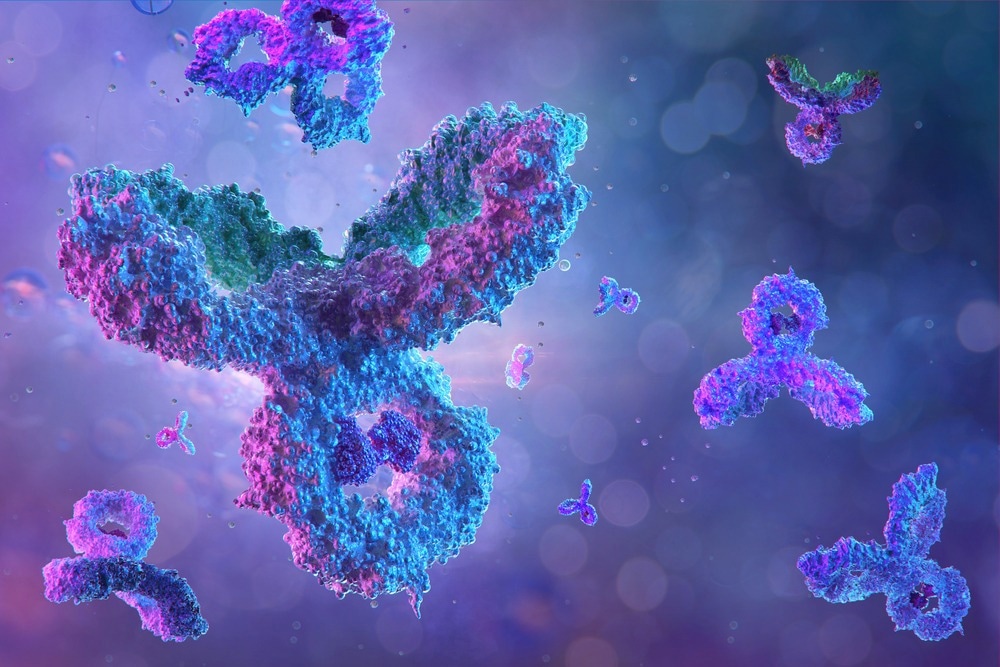In a recent study posted to the bioRxiv* preprint server, researchers in the Netherlands assessed the structure of human circulatory immunoglobulin M (IgM) and its relationship with the small CD5 antigen-like (CD5L) protein. They also investigated the role of CD5L in Fc receptor binding and complement activation.


 *Important notice: bioRxiv publishes preliminary scientific reports that are not peer-reviewed and, therefore, should not be regarded as conclusive, guide clinical practice/health-related behavior, or treated as established information.
*Important notice: bioRxiv publishes preliminary scientific reports that are not peer-reviewed and, therefore, should not be regarded as conclusive, guide clinical practice/health-related behavior, or treated as established information.
IgM is a critical constituent of antibody-mediated immunity and is conserved despite evolutionary processes. Among antibody isotypes, IgM emerges first during immunological responses. Immunoglobulin M is a large-sized (1.0 MDa) multimeric proteinaceous molecule, the structure of which has been reported to be pentameric or hexameric, the former comprising a joining (J) chain.
About the study
In the present study, researchers redefined the structure of serological IgM as a pentamer complexed with CD5L and comprising a J-chain.
The team characterized CD5L and IgM by tracking the associations and abundances of the proteins in sera obtained from 42 healthy donors. To determine the quantity of the protein chains (Igµ, J, and CD5L), bottom-up proteomics with label-free quantitation was performed. Next, pooled sera were subjected to size-exclusion chromatography (SEC) MS analysis.
Enzyme-linked immunosorbent assays (ELISA) were performed to quantify IgM-CD5L complexes. The circulatory IgM structure was analyzed using mass photometry and native charge detection mass spectrometry (CD MS). To investigate IgM and CD5L co-expression among B lymphocytes, memory and naive B lymphocytes were cultured, and supernatant IgM was analyzed.
To investigate IgM-CD5L binding mechanisms, recombinant CD5L (rCD5L) and pentameric IgM-J were produced in vitro. To assess the role of C191 and C300 cysteines in IgM-J-CD5L complex formation, recombinant human CD5L (hCD5L) variants were produced with cysteines mutated to serines, and their IgM-J association abilities were evaluated. Structure prediction analyses were also performed.
Furthermore, the functional implications of CD5L insertion into IgM were investigated using recombinant biotin-specific monoclonal IgM antibodies and assessing their abilities to induce complement component 3 (C3b) deposition and cause lysis of biotinylated human erythrocytes.
Results
Circulatory (serological) IgM exclusively existed as a complex of J-chain-containing pentamers covalently bound to the small CD5L (36.0 kDa) protein via CD5L-Cys191. Contrastingly, secretory IgM in milk and saliva lacked CD5L. Unlike IgM, CD5L was not secreted by B lymphocytes, indicating that CD5L was associated with extracellular IgM.
The findings indicated that CD5L insertion in IgM had several functional consequences, i.e., it reduced the binding of IgM to two receptors, the polymeric Ig receptor (pIgR) and the FcαµR. In contrast, FcµR binding and C1q-medicated complement seemed unaffected by the integration of CD5L and IgM. CD5L occurred synchronously with IgM in circulation. The team detected a mean CD5L serological concentration of 1.70 µM or 60.0 mg/L.
Remarkably, CD5L levels correlated strongly with those of the constant region of IgM’s heavy chain (IgµC), indicating high levels of circulating IgM-CD5L complexes. Further, the CD5L/IgµC ratio was ca. 0.2, close to one CD5L molecule per IgM pentamer. Circulatory IgM was primarily a J-chain-linked pentamer with CD5L.
The IgM-bound CD5L and total IgM levels correlated in the serological samples, indicating that circulatory IgM existed in a complex form with CD5L. In all circulatory IgM samples, shifts closely matching the incorporation of a CD5L molecule was observed in a 1:1:10 ratio of CD5L:J-chain:IgµC. Each IgM molecule was homogeneous in mass and had an oligomeric state. Efficient IgM-rCD5L associations were observed in mildly reducing conditions, indicating that disulfide bonds linking = CD5L and IgM are critical for complex formation.
The formation of IgM-CD5L complexes was verified by the CD5L epitope shielding by two anti-CD5L monoclonal antibodies (mAbs, 7E4, and 10D11) that cannot bind to serological IgM. The C191S amino acid substitution markedly decreased the formation of the complexes, whereas the C300S substitution did not, indicating that C191 may be connected to IgM by disulfide bonds. CD5L was positioned in the pentameric IgM-Fc gap, and the secretory component 3 (SRC3) domain was proximal to the joining chain junction between the J chain’s C- and N-terminal loops.
SRC2 was situated on top of the partition separating the Fc-Cμ3 and Fc-Cμ4 domains of the J chain’s N-terminal, positioning C191 near an unpaired cysteine 414 (Cys414) residue of IgM, and SRC1 was flexible. CD5L-J-IgM equivalently activated the complement, and the rIgM-J antibodies, with or without CF5L, induced cell lysis and C3b deposition in comparable amounts. Likewise, investigating CD5L’s effects on complement component 3 deposition using monoclonal antibodies that bind to the Staphylococcus aureus cell wall-glycopolymer, teichoic acid yielded similar results.
Based on the study findings, the canonical form of human serological IgM is a J-chain-linked pentamer with one molecule of the CD5L protein.
Professor Albert J.R. Heck
We contacted the lead author, Professor Albert J.R. Heck from Utrecht University, for comment.
Sometimes in science, you find something so obvious that you wonder why no one has seen this before? You work with your lab on this finding for years to make sure you make no mistake, but then you hear that a befriended colleague independently made the same discovery. We started to work together and generated complementary biochemical, biophysical, structural, and functional data. Now we are ready to share it. The title says it all: CD5L is a canonical component of circulatory IgM!
IgM is one of the key and abundant immunoglobulins in our blood and plays a dominant role in our immune response. In sharp contrast with decades of textbook knowledge about its structure, we define the protein CD5L as an ever-present component of human serum IgM.
Unlike IgM and the J-chain, CD5L is not produced by B cells, implying that it associates with IgM in the extracellular space. We also demonstrate that CD5L integration has functional implications, i.e., it diminishes IgM binding to two of its receptors, the FcαµR and the polymeric Immunoglobulin receptor (pIgR).
These findings are of high fundamental interest, but as IgM is increasingly developed as a therapeutic, we feel our findings should also impact the biopharmaceutical arena. – Professor Albert J.R. Heck

 *Important notice: bioRxiv publishes preliminary scientific reports that are not peer-reviewed and, therefore, should not be regarded as conclusive, guide clinical practice/health-related behavior, or treated as established information.
*Important notice: bioRxiv publishes preliminary scientific reports that are not peer-reviewed and, therefore, should not be regarded as conclusive, guide clinical practice/health-related behavior, or treated as established information.
- Preliminary scientific report. Oskam, N. et al. (2023) "CD5L is a canonical component of circulatory IgM". bioRxiv. doi: 10.1101/2023.05.27.542462. https://www.biorxiv.org/content/10.1101/2023.05.27.542462v1
Posted in: Medical Science News | Medical Research News | Disease/Infection News
Tags: Amino Acid, Antibodies, Antibody, Antigen, Biopharmaceutical, Blood, Bottom-Up, Cell, Cell Lysis, Cell Wall, Chromatography, Cysteine, ELISA, Enzyme, Fc receptor, Immune Response, immunity, Immunoglobulin, in vitro, Mass Spectrometry, Molecule, Protein, Proteomics, Receptor, Spectrometry, Staphylococcus aureus

Written by
Pooja Toshniwal Paharia
Dr. based clinical-radiological diagnosis and management of oral lesions and conditions and associated maxillofacial disorders.
Source: Read Full Article


